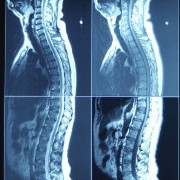Although it is likely you have heard of this medical condition and understand it has to do with the curvature of your spine, there is much more to scoliosis than meets the eye. For instance, did you know that scoliosis affects approximately seven million people in the United States? Or, did you know 2 to 3 percent of Americans have it by the time they are 16 years old?
As you grow, your spine naturally forms with slight curves at the head and tail, but a typical healthy spine should represent a straight line. However, a spine with scoliosis has a prominent “S” or “C” shape curve.
Risk factors for scoliosis comes in four classifications: congenital, idiopathic, degenerative and neuromuscular. So, who does this put at risk?
Signs of scoliosis from birth is referred to as congenital. This vertebral abnormality is quite prevalent genetically, so it is not surprising if your child is born with it, when you or a family member had or has scoliosis.
Idiopathic is used when referring to scoliosis in infants, juveniles, adolescents or adults. You can also classify the condition as idiopathic if the cause of scoliosis is unknown, which can be the case more often than not. Scoliosis most commonly strikes female juveniles and adolescents during growth spurts. Fortunately, more times than not, the child will grow out of it. I am a perfect example.
To add to my long list of medical conditions (as writing all these articles has so rudely pointed out) I had an idiopathic case of scoliosis. It was detected at an annual physical exam when I was in middle school, I was about age 12. I was sent to a back doctor, where I was examined up, down, left and right. The final conclusion was a prolific combination of weird things: bad posture, Brown’s syndrome and my right leg longer than the left. In other words, I was a lop-sided hormonal pre-teen with bad posture. Try explaining that to a 12 year old girl with braces and bad hair!
Long story short, my doctor gave me back stretches to do nightly, sent me to an eye doctor to treat my Brown’s syndrome and I paid a little more attention to my posture in band class (especially since I was holding up the largest instrument in the lineup, a tuba). Fourteen years and some odd number of tuba lessons later, I am a perfectly fine, very healthy young woman with no signs of scoliosis, or other serious medical conditions for that matter. Yes, I still have Brown’s syndrome, but that is a different story for a different day. Moral of this story is, like most juveniles and adolescents, I grew out it and was able to sustain a normal active lifestyle with a healthy spine and your children can too.
As lucky as I was to stave off future complications with scoliosis, others are not. If scoliosis is the consequence of a pre-existing condition, then you are suffering from a scoliosis risk factor known as neuromuscular.Nueromuscular scoliosis is when the condition develops as a secondary symptom to a pre-exisiting condition such as spina bifida, cerebral palsy or muscular dystrophy. In this case, treatment for the primary condition will greatly effect the your treatment for scoliosis.
The fourth and final risk factor for scoliosis is degenerative. This may result from an injury, bone collapse, previous back surgery or osteoporosis. Any one of any age is prone to this risk factor. As you can imagine with degenerative scoliosis, your condition will worsen over time.
Factually speaking, scoliosis is a condition that is extremely prevalent in childhood girls for idiopathic reasons like genetics. This is why it is crucial to have your daughters spine checked at her next annual exam. If my case of scoliosis hadn’t been detected and I continued to lug a tuba on my back and march around the football field for the remaining years of school without seeing a specialist, my spine might not be in the healthy condition it is in now.
If you or someone you know is potentially suffering from scoliosis and not aware of it, check back Wednesday to find out some prominent symptoms and how to detect if scoliosis is a secondary condition to a pre-existing condition. Also, we will discuss some management tactics to help your spine recover before surgery is your last resort.




Add a CommentComments
There are no comments yet. Be the first one and get the conversation started!